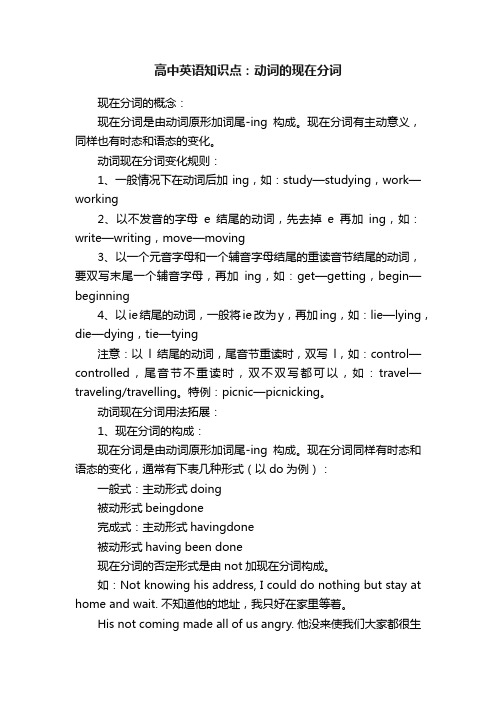高中英语 现在分词、不定式以及原型
- 格式:doc
- 大小:43.00 KB
- 文档页数:4

高中英语非谓语的知识点总结高中英语非谓语的知识点总结非谓语是指除了动词原形和动词不定式之外的动词形式,包括分词和动名词。
高中英语非谓语在英语学习中扮演着重要的角色,掌握非谓语的基础知识能够帮助我们更加深入地了解英语,也能够提升我们的英语表达能力。
本文将从非谓语的形式、用途以及常见的四种非谓语形式等方面进行总结。
一、非谓语的形式非谓语包括动名词、现在分词、过去分词和不定式。
1. 动名词动名词是由动词加上-ing构成。
动名词可作主语、宾语、表语、宾语补足语和定语等。
例如:- Swimming is good for health. 游泳对健康有益。
- He enjoys reading books. 他喜欢看书。
- My favorite hobby is playing basketball. 我最喜欢的爱好是打篮球。
- She found him sleeping on the sofa. 她发现他在沙发上睡觉。
- The man who is wearing a hat is my uncle. 戴帽子的那个男人是我的叔叔。
2. 现在分词现在分词是由动词加-ing构成。
现在分词可作定语、表语、状语等。
例如:- She saw a man smoking outside. 她看到一个男人在外面吸烟。
- The book is interesting and worth reading. 这本书很有趣,值得一读。
- Running late, she took a taxi to the airport. 她来不及了,就乘坐了出租车去机场。
3. 过去分词过去分词是由动词的过去分词形式构成。
过去分词可作定语、表语、宾语补足语、完成时和被动语态等。
例如:- She saw a broken mirror in the box. 她在盒子里看到一面破镜子。
- She seemed to be frightened by the noise. 她似乎被噪音吓到了。

高中英语知识点:动词的现在分词现在分词的概念:现在分词是由动词原形加词尾-ing构成。
现在分词有主动意义,同样也有时态和语态的变化。
动词现在分词变化规则:1、一般情况下在动词后加ing,如:study—studying,work—working2、以不发音的字母e结尾的动词,先去掉e再加ing,如:write—writing,move—moving3、以一个元音字母和一个辅音字母结尾的重读音节结尾的动词,要双写末尾一个辅音字母,再加ing,如:get—getting,begin—beginning4、以ie结尾的动词,一般将ie改为y,再加ing,如:lie—lying,die—dying,tie—tying注意:以l结尾的动词,尾音节重读时,双写l,如:control—controlled,尾音节不重读时,双不双写都可以,如:travel—traveling/travelling。
特例:picnic—picnicking。
动词现在分词用法拓展:1、现在分词的构成:现在分词是由动词原形加词尾-ing构成。
现在分词同样有时态和语态的变化,通常有下表几种形式(以do为例):一般式:主动形式doing被动形式beingdone完成式:主动形式havingdone被动形式having been done现在分词的否定形式是由not加现在分词构成。
如:Not knowing his address, I could do nothing but stay at home and wait. 不知道他的地址,我只好在家里等着。
His not coming made all of us angry. 他没来使我们大家都很生气。
2、现在分词的一般式和完成式:现在分词的一般式表示和谓语动词所表示的动作同时进行的动作;完成式表示在谓语动词所表示的动作之前发生的动作。
如:Being a student, he was interested in books. 作为一个学生,他对书本很感兴趣。


高中英语语法复习天津市汉沽区第五中学刘华态主动态被动态式一般式1.being2.doingbeing done完成式having done having been done 否定式1.not being2.not doing3.not having done1.not being done2.not having beendone现在分词的形式现在分词短语的构成•1、现在分词有自己的宾语The teacher entered holding some books.•2、现在分词有自己的状语We saw a boat coming slowly towards us.•3、现在分词有时有它单独的逻辑上的主语(亦称独立主格结构)Mother being ill, I had to stay at home.•表示主动的意义1、它与被修饰的中心词(作定语)the boy standing by the windowthe sleeping child2、它与句子的主语之间(表语或状语)The film is exciting.She sat by the road, crying loudly.3、它与自己的逻辑主语之间(独立主格)There being no bus, they had to walk home.•从时间意义来讲1、表示动作正在进行Do you know the man talking to the manager?2、表示经常性、习惯性或现在的状态的动作They live in a room facing south.Being a student,he was interested in books3、表示动作语谓语动词同时发生We worked there for a week, helping them to get in wheat.4、表示动作在谓语动词之前发生(一般用现在分词的完成式)Not having received an answer, he decided to write another letter to them.Having studied in the university for 3 years,he knows the way very well。


动名词与现在分词动名词1、基本形式一般主动doing 一般被动being done完成主动having done 完成被动having been done(完成式表示动作发生在谓语动词表示的动作之前)造句(1)对牛弹琴。
(2)读法语比说法语更容易。
(3)他后悔(regret)没有听你的,才导致了这个错误。
动名词的否定式用“not + 动名词” 构成Her not having done her homework made her teacher very angry.I don't remember having ever been given a chance to do it.2、动名词具有名词的性质(V-ing形式起名词作用→动名词;而V-ing作形容词或副词→现在分词)动名词可作主语、宾语、表语、定语(1)作主语●如:吸烟会导致癌症。
●It做形式主语,此时真正主语为动名词(短语)It is no use/ no good / useless / worthwhile / a waste of time doing sth.It 's no use (complain)without taking any action.It's a waste of time (talk)about such useless things.●动名词作主语表示经常性的动作;表示泛指的概念、习惯或经验Being invited to the palace ball made her very excited.(注意:不定式作主语则指将要或者一次性的动作)To be invited to the palace ball will be exciting.●单个动名词(短语)作主语时,谓语动词一般用单数形式。
(2)作宾语They advised (solve) the problem in this way.The bike needs repairing.= The bike needs to be repaired.(3)作表语。
英语非谓语动词精讲2.非谓语动词的变化形式Infinitive (不定式)不定式的根本形式to-infinitive bare-infinitive1. 作主语1)不定式做主语一般表示具体的某次动作,尤其是未发生的行为动作。
2)不定式做主语可直接位于句首,但当主语较长时,常用it做形式主语,而将不定式放到谓语的后面。
It is important for modern young people to master at least two foreign languages.常见句型构造:a)It is+形容词+不定式It is not easy to catch fish with your hands only.b)It i+名词+不定式It is important for us young people to learn English and master it.c)It takes/needs/requires(sb.)some time(determination, energy,patience...)+不定式It takes me three hours to learn English each day.2. 作宾语1)不定式作宾语不定式常在以下动词后面作宾语:afford,agree,aim,apply,appear,arrange,ask,attempt,beg ,care,choose,claim, ,dare,demand,decide,d esire,determine,expect,fail,hope,hesitate,intend,learn,manage,offer,plan,prepare,pretend,promise,ref use,seek,tend,threaten,want,wish等。
2)在“主语+动词+it+宾补+不定式〞构造,it作形式宾语:We found it impossible to get everything ready in time.I think it important to learn English well in college.使用这种句型的常见动词有:believe,consider,declare,feel,find,guess,imagine,make,prove,realize,suppose,think,等。
非谓语动词在高中英语中,非谓语动词包括动词不定式(to do)、动名词(-ing)、现在分词(-ing)与过去分词(-ed)三种形式,它们有不少共同特点:①在句子中不能充当谓语,不受主语人称和数的限制;②保留部分动词特性:可以后接宾语,可用副词修饰;③否定形式,都是在其前面加上not/never等否定词;④表示的动作,如果明显发生的谓语动词表示的动作之前(或者强调先后),要求用完成时态形式;⑤都不能作地点状语,只有动词不定式可以作目的状语;⑥没有主语,其表示动作的执行者叫作“逻辑性主语”(主动语态时),有时表示动作的承受者(被动语态时)非谓语动词可充当句子的很多成分,并且有时态和语态的变化如下:III 现在分词一.现在分词的时态和语态形式,同动名词二.现在分词的功能1.现在分词作表语:1)现在分词作表语,表示主语的性质特征,“令人……的”,相当于一个形容词;e.g. ①The storybook is interesting.② The sudden news was quite surprising.2)现在分词作表语,表示主语正在(主动)进行的动作;e.g. ①The boy is sleeping.② The sudden news was quite spreading.2.现在分词作定语:1)现在分词作定语,表示被修饰词语的性质特征,“令人……的”,相当于一个形容词;e.g. ①They are interesting storybooks.② The exciting news made us all jumped with joy.2) 现在分词作定语, 表示主动正在进行的动作;e.g. ①I can see a sweeping boy on the tree.②The sleeping cat is only five years old.3.现在分词作宾语补足语:1)现在分词在感官动词后面作宾补,如:see, hear, feel, notice, watch, look at, listen to, observe, find, smell etc.;e.g. ① I saw the children playing toys in the yard.﹥ The children were seen playing toys in the yard.② When I came back last night, I heard my neighbor quarrelling.﹥ My neighbor were heard quarrelling when I came back last night.2) 现在分词在使役动词后面作宾补,如:have, let, make, set, send, keep(使), catch(撞见)etc.e.g. ① She kept us waiting for half an hour.﹥ We were kept waiting for half an hour.② They have devoted themselves to the great career.﹥ They have been devoted to the great career.※现在分词在作宾语补足语时,与动词不定式的区别。
高中英语语法非谓语动词详解高中英语语法非谓语动词详解在高级英语语法中,非谓语动词是非常重要的一部分,也是理解和掌握英语语法的关键。
非谓语动词在句子中扮演着重要的角色,可以表达不同的意思和功能。
本文将详细解释非谓语动词的定义、类型和用法,并通过实例进行分析和解释。
一、定义和类型非谓语动词指的是在句子中不作为主要动词的动词形式,它们可以表达动词本身的含义,但没有主语和谓语动词。
非谓语动词包括动词不定式、动名词和分词三种类型。
1、动词不定式:动词不定式是以“to+”动词原形构成的,表示动词的不同形式,如“to do”、“to being”、“to have done”等。
2、动名词:动名词是在动词后加上“-ing”构成的,表示动词的现在分词形式,如“playing”、“swimming”、“jumping”等。
3、分词:分词是动词的过去分词形式,分为现在分词和过去分词两种。
现在分词表示动词的动作正在进行,如“running”、“singing”、“dancing”等;过去分词表示动词的动作已经完成,如“finished”、“eaten”、“read”等。
二、非谓语动词的用法非谓语动词在句子中可以扮演不同的成分,如主语、宾语、状语等。
下面我们通过具体的例子来分析非谓语动词的用法:1、动词不定式:在句子中,动词不定式可以作为主语、宾语和状语等。
例如,“To learn English is important”(学习英语很重要)中,动词不定式“to learn English”作为主语;或者在“I want to go home”(我想回家)中,动词不定式“to go home”作为宾语。
2、动名词:在句子中,动名词可以作为主语、宾语和状语等。
例如,“Playing sports is fun”(做运动很有趣)中,动名词“Playing sports”作为主语;或者在“I enjoy listening to music”(我喜欢听音乐)中,动名词“listening to music”作为宾语。
一、含ing的用法 1.carry on\keep doing 坚持做某事 2. practise doing sth. 练习做某事 3. keep sb. doing 使某人一直做某事 4. enjoy doing 喜欢做某事 5. finish doing 完成做某事 6. be afraid of doing 害怕做某事 7. (sth)be worth doing 值得做 8. be busy doing 忙于做某事 9. how about doing//what about doing 做某事怎么样 10. spend some time (in)doing 花时间做某事 11. spend some money (in) buying 花钱做某事 12. feel like doing 想做某事 13. stop/keep/prevent … from doing 阻止某人做某事 14. thank sb for doing 感谢某人做某事 15. thanks for doing 感谢做某事 16. do some cooking/cleaning/reading/shopping/washing 做点饭、打扫一下卫生、读点书、逛逛街、洗洗衣服 17. go swimming/fishing/shopping/skating/boating 去游泳、钓鱼、逛街、滑冰、划船 18. mind doing 介意做某事 19. prefer doing … to doing… 比起做某事更喜欢做某事 20. can’t help doing 情不自禁做某事 21. have fun/difficulty/trouble/problem doing sth. 做某事有趣、有困难、有困难、有困难 22. waste time/money doing 浪费时间、钱做某事 23. instead of doing 代替做某事 24. miss doing 错过做某事 25.admit/acknowlodge doing 承认做某事 26.risk doing 冒险做某事 27.imagine doing 想象做某事 28.deny doing 否认做某事 29. postpone(缓期,展缓) /put off doing 推迟做某事 30. look forward to doing 期待做某事 31. stick to doing 坚持做某事 32. object to doing 反对做某事 33. be accustomed to /be used to doing 习惯做某事 34. succeed in doing 成功做某事
二、又接to 又接ing ,其意义不同 1 try to do努力 Try ding 试试看(另外一种方法)
2 mean to do 打算 Mean doing 意味,(To catch the first train means getting up at 4:00) 3 consider to do 认为He is considered to have invented the first computer Consider doing打算
4 regret to do 遗憾地去I regret to tell that our team has lost the game. Regret doing 后悔做了
5.stop to do sth ;stop doing sth (停止去做某事;停止正在做的事) 6.remember to do sth ;remember doing sth (记得去做某事;记得曾做过某事)
7.forget to do sth ; forget doing sth (忘记去做某事;忘记曾做过某事) 8 go on to do sth ; go on doing sth (继续去做另一件事;继续去做上一件事) 8 propose to do 打算(要做某事) propose doing 建议(做某事)
9 allow/ permit sb to do Allow/ permit doing (we don’t allow smoking in the office)
10 like /love/hate/ …+ to do 表示具体行为,表示次数(今天这次) Like /love /hate +doing 表示抽象、倾向概念 习惯性,经常
(注)如果这些动词前有should/would 词,其后宾语只跟不定式,不能跟动名词。例如: I should like to see him tomorrow. ---would you love to go skiing with me ? ---- I like skiing,but today I don’t like to
10 need, want, require +ing表被动意义; Need\ want \ require + to be done 才有被动意义
11 be afraid of doing担心 be afraid to do 怕,不敢 He left the room silently, being afraid of waking his mother.
三、含有ing的句型 1. there be no sense\point\..trouble difficulty ….doing 2. it be no use\ good \help\fun \a waste of time doing 3. there be a chance\ opportunity \possibility ..of doing 四、过渡词(固定用法,要背住) 1 Generally speaking 2 Judging from/by 3 Frankly speaking 4 To tell the truth 5 Given假设,倘若 ( Given the general state of his health ,it will take long to recover.) 6 Considering something,\something considered 考虑到 7 provided \providing 假设 8 Including something\ Something included 9 supposing 假设
五、含有不带to的动词不定式句型: 1. had better (not) do sth. 最好(不)做某事 2. would you please (not) do sth. 你可以做某事吗? 3. why not do sth. 为什么不做某事? 4. why don’t you do sth. 为什么你不做某事? 5. Shall we do sth.? 我们要做某事吗? 6. let sb do sth. 让某人做某事 7. make/have sb. do sth. 使某人做某事
六、含有带to的动词不定式句型: 1. It’s time to do sth. 现在是做某事的时候了 2. It takes sb. some time to do sth. 做某事花了某人时间 3. tell/ask/want/encourage/invite/ sb. to do sth. 告诉、叫、想、鼓励、邀请某人做某事 4. Would you like to do sth.? 你想做某事吗/ 5. It’s good/bad to do sth. 做某事好、不好 6. It’s good/bad for sb.to do sth. 某人做某事好、不好 7. be+adj.+enough to do sth. 足够+形容词做某事 8. sb. is ready to do sth. 某人准备好做某事 9. It’s+adj.+ for sb. to do sth. 做某事对某人+形容词(做这件事对你好) 10. It’s+adj.+ of sb. to do sth. 某人做某事+形容词 (你做这件事真好) 11. would like/love /decide/want/wish/to do sth. 想、喜欢、决定、想、希望做某事 12. would like/love sb. to do sth. 想、喜欢某人做某事 13. Prefer to do sth. rather than do sth. 宁愿做某事而不愿做某事 I prefer to stay at home rather than go out. 我宁愿呆在家里不愿出去 14. how/ when/where/whether to do sth 怎么、什么时候、在哪里、要不要做某事 15. can’t wait to do 迫不及待做某事 16. too … to do … 太怎么样而不能做某事 17. be afraid /ready/able/sure to do 害怕、准备、能够、确定做某事 18. seem to do 似乎做某事
七、下列结构用带to的动词不定式和ing形式含义相同: 1.begin to do/doing 开始做某事 2.start to do/doing 开始做某事 3.continue to do/doing 继续做某事
八、既用不带to的动词不定式又用现在分词的句型: 用不带to的动词不定式强调动作的完成过程;用现在分词强调动作的进行状态。 1.hear sb do sth./doing 听见某人做某事 听见某人正在做某事 2.listen sb do sth./doing 听某人做某事 听某人正在做某事 3.look at sb do sth./doing 看某人做某事 看某人正在做某事 4.see sb do sth./doing 看见某人做某事 看见某人正在做某事 5.watch sb do sth./doing 观察某人做某事 观察某人正在做某事 6.notice sb do sth./doing 注意到某人做某事 注意到某人正在做某事